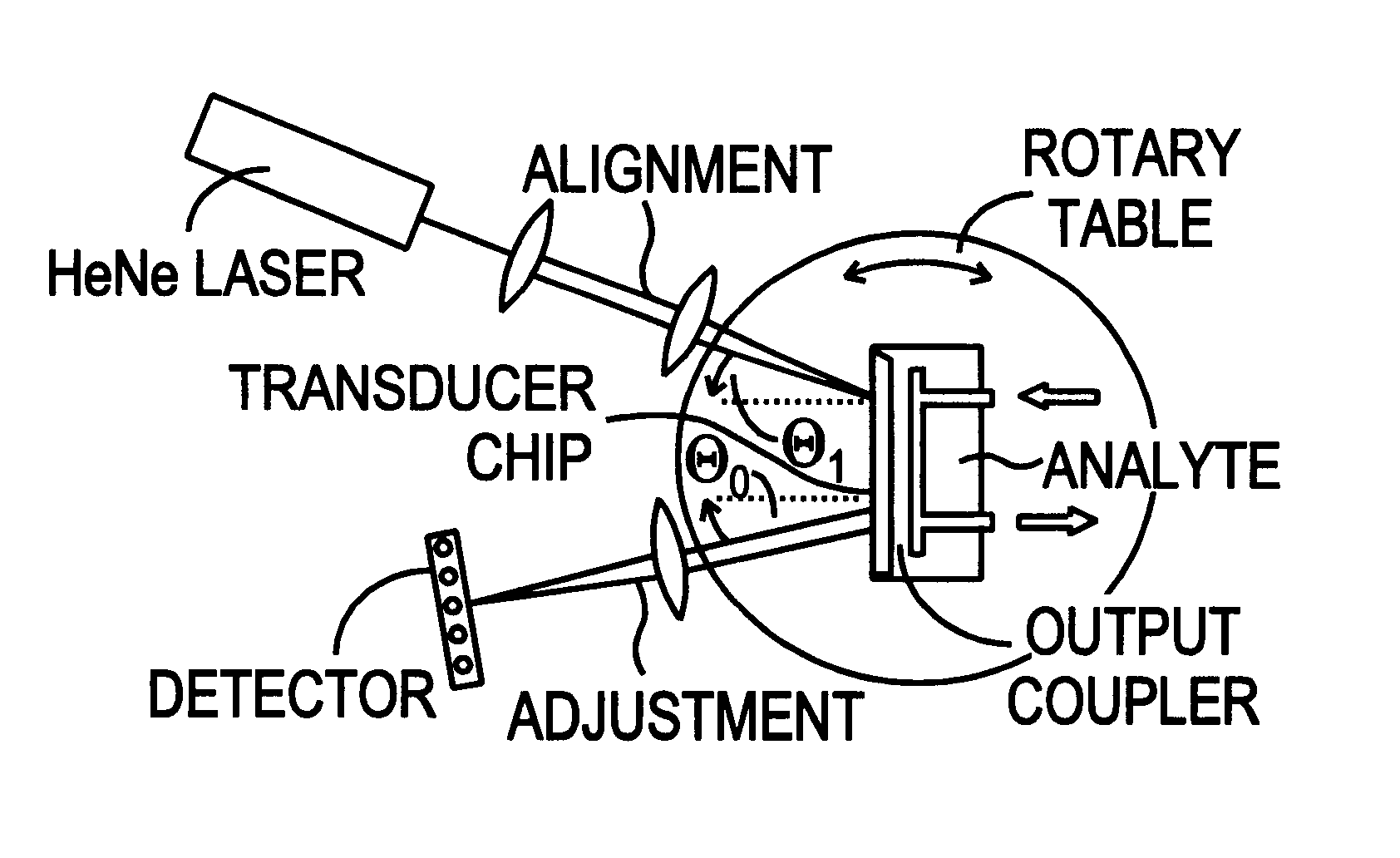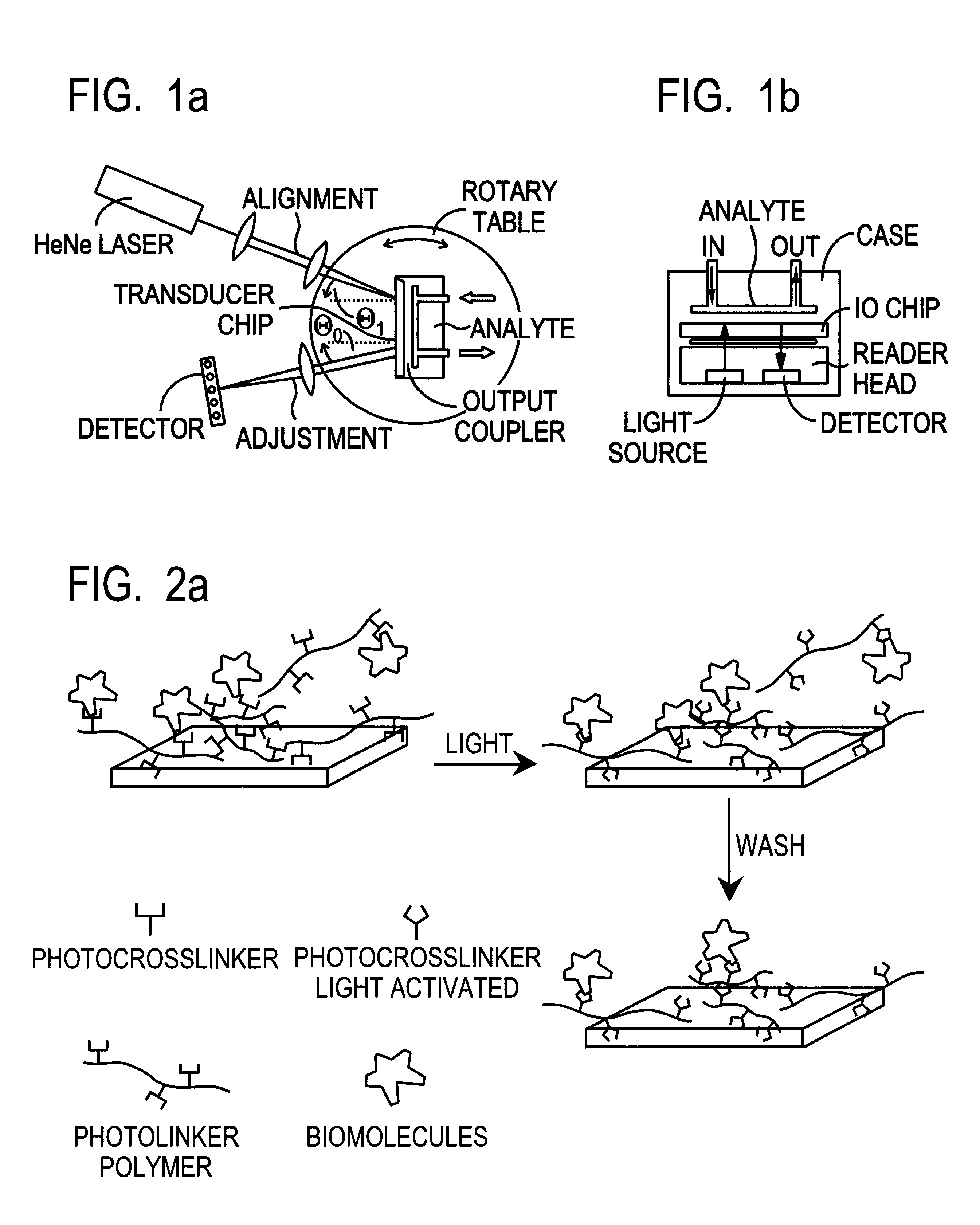Optical sensor unit and procedure for the ultrasensitive detection of chemical or biochemical analytes
an analyte detection and ultra-sensitive technology, applied in biochemistry equipment and processes, biochemistry apparatus and processes, material testing goods, etc., can solve the problems of limiting the immunological detection method to procedures including denaturation of samples prior to detection, the overall duration of the test is limited by known analyte detection techniques in terms of sensitivity and quantification, and the overall duration of the test is limited. , to achieve the effect of high sensitivity
- Summary
- Abstract
- Description
- Claims
- Application Information
AI Technical Summary
Benefits of technology
Problems solved by technology
Method used
Image
Examples
example 1
Design Fabrication and Testing of Biosensor Chips
Detection of immunological interactions between recombinant bovine PrP and monoclonal anti-PrP antibodies is accomplished by combining optical waveguide detection and light-addressable photobonding. In view of the exceedingly small quantities of analytes in test samples (10.sup.5 to 10.sup.8 molecules), biosensor technologies must meet the requirements of high sensitivity and low non-specific binding. Designed for routine analysis, the detection system preferably consists of few components, fast in response (measuring time in the order of minutes or shorter) and suitable for mass production. The availability of disposable sensor devices, combined with multiple sensing and referencing pads on a single device is advantageous for diagnostic analysis.
I. Optical Waveguide Design and Fabrication
To adapt the resolution and dynamic range of the sensor chip to the needs of diagnostic application, corresponding substrates are fabricated. The gr...
example 2
Building of a Biosensor Module
Since PrP.sup.BSE only occurs in combination with infectious particles, it is important to have a mobile biosensor module which can be used under biosafety conditions P2. A new compact and miniaturized IO sensor module was constructed and designed. A schematic drawing of such a module is shown in FIG. 5.
The complete module consists of three distinct submodules. The tasks of the submodules are illumination (i.e. to provide the optical input), signal transduction into an on-chip measuring variable and signal evaluation. In the sensor module shown in FIG. 5, the electrical input connector (laser driver) powers a laser diode (CD laser diode at 785 mm) for illumination of the sensor chip. A fluid handling system (tubings in the back) is used for analyte application. The sensor output signal is detected using an one-dimensional photodiode array. In this example, the electrical output signal is fed into a laptop computer (RS232 interface) via the connector to ...
example 3
Detection of PrP.sup.BSE
The functional biosensor module as described above was used to test the detection of bovine PrP.sup.Sc. Specifically, the chips carrying either immobilized 6H4 or 15B3 were incubated with proteinase K-digested brain homogenates from normal or BSE-sick cattle. From Western blotting experiments, it is known that about 10-30% of total PrP in a BSE-infected brain correspond to PrP.sup.BSE. Using the above described procedures, antibodies immobilized on the chips were incubated with proteinase K digested brain homogenates. No signal was observed in normal brain while specific binding was detected in homogenates from BSE-sick animals. For antibody 15B3, undigested homogenates were used and a signal was detected only in homogenates from BSE-sick cattle.
This method was further tested for the detection of PrP.sup.BSE in organs other than brain. The exquisite sensitivity of the biosensor system allowed to detect Pre SE in spinal fluid, lymphoid organs, blood, saliva or...
PUM
| Property | Measurement | Unit |
|---|---|---|
| Molecular weight | aaaaa | aaaaa |
| Area | aaaaa | aaaaa |
| Sensitivity | aaaaa | aaaaa |
Abstract
Description
Claims
Application Information
 Login to View More
Login to View More - R&D
- Intellectual Property
- Life Sciences
- Materials
- Tech Scout
- Unparalleled Data Quality
- Higher Quality Content
- 60% Fewer Hallucinations
Browse by: Latest US Patents, China's latest patents, Technical Efficacy Thesaurus, Application Domain, Technology Topic, Popular Technical Reports.
© 2025 PatSnap. All rights reserved.Legal|Privacy policy|Modern Slavery Act Transparency Statement|Sitemap|About US| Contact US: help@patsnap.com



